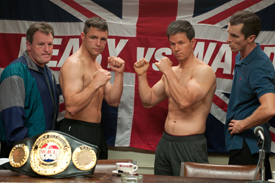
Films about boxing and its troubled athletes are nothing new, with Rocky, Raging Bull and Cinderella Man being some of the most prominent movies portraying a down-and-out individual’s relationship with the bloody sport. From this perspective, David O. Russell’s The Fighter does not do anything original. Yet somehow, the movie — which is based on a true story — manages to keep its audience engaged.
Mark Wahlberg (The Other Guys) plays Micky Ward, a boxer from Lowell, Mass., who is trained by his older half-brother, Dickie Eklund (played by a gaunt-looking Christian Bale, Public Enemies). While Eklund became a local hero for knocking out Sugar Ray Leonard in 1978 and was labeled “The Pride of Lowell,” Micky has struggled to make a name for himself due to the questionable business decisions made by his mother Alice (Melissa Leo, Conviction) and the crack-addicted Dickie.
Micky, a hardworking and talented man, seems to come up short when it matters the most. After suffering a terrible loss due to interference from his family members, he questions whether their involvement is beneficial to his career and finds comfort in his new girlfriend, Charlene (Amy Adams, Love and Distrust). The headstrong Charlene urges Ward to break away from his family and find other alternatives. What follows is a bitter conflict between Micky, Charlene and Micky’s family.
The Fighter plays out like a typical underdog sports story, but what makes it different from other films is its emphasis on the interpersonal relationships and how Micky copes with his aggressive family members, especially Dickie. Boxing is an integral part of the movie, but it never dominates. Rather, the focus is on character development and human interactions. The film never veers off into melodrama by carefully maintaining a steady dose of conflict and tense dialogue interspersed with humor and adrenaline-filled fight sequences.
Where The Fighter distinguishes itself from previous boxing films are the realistic boxing scenes. Using real commentary from the original HBO broadcasts and recreating the scenes from Micky’s actual fights shot by shot, The Fighter puts its viewers in Micky’s corner and uses precise camera work to fully involve the audience in the fight. Add in Wahlberg spending four years training for the role and not using a stunt double for the fight scenes, and The Fighter clearly is superior to other films in this regard.
Wahlberg’s role as the introverted Micky is very utilitarian, yet effective. In contrast to the hyper performance by Leo as his mother, Wahlberg turns in a satisfactory and subdued performance; one that is ultimately overshadowed by Bale’s excellent portrayal of Dickie.
With all his lost weight making him look like a cadaver, Bale is almost unrecognizable in the film as he fully assimilates Dickie’s quirks and antics into his performance. His portrayal is fully appreciated when the real Micky and Dickie appear during the end credits and the audience grasps how adeptly Bale adopted Dickie’s mannerisms.
Bale’s performance is the best part of The Fighter, and his character serves as the driving force of the plot. Although he had less screen time than Wahlberg, Bale’s presence is felt throughout the movie and is what makes watching The Fighter worth the time.
The Fighter is not a great movie, but it takes a commonplace plot and succeeds in making the most out of it.
RATING: 3.5 stars out of 5
sthaper@umdbk.com



